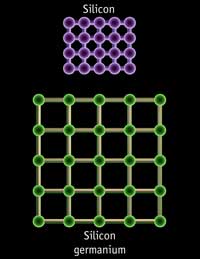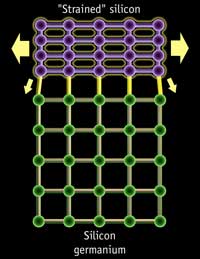Intel's Pentium 4 E: Prescott Arrives with Luggage
by Anand Lal Shimpi & Derek Wilson on February 1, 2004 3:06 PM EST- Posted in
- CPUs
Something to be proud about
Intel is particularly proud of their 90nm process as it incorporates new technologies that are a first in desktop microprocessors. The biggest of them all is the use of Strained Silicon, which we explained back in August of 2002 when Intel first announced that they would use the technology:
Strained Silicon works by effectively stretching the silicon in the channel region of the transistor. The engineers at Intel's fab facilities don't sit there and pull on both ends of the silicon in order to get it to stretch; rather they place the silicon on top of a substrate whose atoms are already spaced further apart than the silicon that needs to be stretched. The result of this is that the silicon atoms on top of the substrate will stretch to match the spacing of the substrate below, thus "stretching" the silicon in the channel.
 |
 |
|
Silicon is "strained" by using a substrate of more widely spaced atoms below the silicon channel of a transistor. (Images courtesy of IBM) |
|
With more well spaced silicon atoms, electrons can now flow with less resistance in the channel meaning that more current can flow through the channel when needed. The end result is a 10 - 20% increase in drive current, or the current flowing through the channel of the transistor.
![]()
Intel claims that their Strained Silicon technology has no real downsides (unlike competing solutions) other than its 2% increase in manufacturing costs. Intel's 90nm process will make use of Strained Silicon technology to improve the performance of their 90nm transistors.
Intel’s 90nm process does not make use of Silicon on Insulator and according to their manufacturing roadmaps it never will. Intel will introduce SOI on their 65nm process in 2005.

Prescott's 112 mm^2 die
Prescott is Intel’s first desktop microprocessor to have 7 metal layers, 2 fewer layers than AMD’s Athlon 64. Intel had to add the 7th layer simply because of the skyrocketing transistor count of Prescott (125 million vs. Northwood’s 55 million). It’s not normally desirable to increase the number of metal layers you have on a chip as it increases manufacturing complexity and cost, but in some cases it is unavoidable. The fact that Intel was able to keep the number of metal layers down to 7 is quite impressive, as AMD had to resort to 9 layers dating back to the introduction of their Thoroughbred-B Athlon XP core to keep clock speeds high.
|
CPU Core Comparison |
|||||
| Code Name |
Willamette |
Northwood |
Northwood EE |
Prescott |
AMD Athlon 64 |
| Manufacturing Process |
0.18-micron |
0.13-micron |
0.13-micron |
90 nm |
0.13-micron |
| Die Size |
217 mm^2 |
131 mm^2 |
237 mm^2 |
112 mm^2 |
193 mm^2 |
| Metal Layers |
6 |
6 |
6 |
7 |
9 |
| Transistor Count |
42 Million |
55 Million |
178 Million |
125 Million |
105.9 Million |
| Voltage |
1.750V |
1.50V |
1.50V |
1.385V |
1.50V |
| Clock Speeds |
1.3 - 2.0GHz |
1.6 - 3.4GHz |
3.2 - 3.4GHz |
2.8 - 4GHz+ |
2.0GHz+ |
| L1 Instruction/Trace Cache | 12K µops |
12K µops |
12K µops |
12K µops |
64KB |
| L1 Data Cache | 8KB |
8KB |
8KB |
16KB |
64KB |
| L2 Cache | 256KB |
512KB |
512KB |
1MB |
1MB |
| L3 Cache | N/A |
N/A |
2MB |
N/A |
N/A |










104 Comments
View All Comments
Stlr22 - Sunday, February 1, 2004 - link
post*Stlr22 - Sunday, February 1, 2004 - link
KristopherKubickiEarlier you said that I should read the article.
What was your point? What was it about my first pot that you disagreed with?
KristopherKubicki - Sunday, February 1, 2004 - link
#7:I agree 100% with Anand and Derek. This processor will be a non-event until we get in the 3.6GHz range. Similar to Northwood's launch.
#10:
Check out our price engine. We have already been listing the processor a week!
http://www.anandtech.com/guides/priceguide.htm
http://www.monarchcomputer.com/Merchant2/merchant....
cliffa3 - Sunday, February 1, 2004 - link
In the table on page 14 it shows that the 90nm P4@2.8 will have a 533 MHz FSB, but is that the case? I did some quick google research and can't find anything to support that...please confirm or correct, thanks.NFactor - Sunday, February 1, 2004 - link
Yes, I must agree this is an amazing article, one of the best i have ever read. Thanks.Xentropy - Sunday, February 1, 2004 - link
VERY interesting article. Thank you Anand and Derek! One of the best I've read on Anandtech, and I consider yours the best hardware site on the net!One correction, on page 7, you say, "if you want to multiply a number in binary by 2 you can simply shift the bits of the number to the right by 1 bit," but don't you mean shift to the left one bit (and place a zero at the end)? It's much like multiplying a decimal number by ten for obvious reasons.
Anyway, it looks like the Prescott is somewhat of a non-event at this time. Just new cores that perform fundamentally the same as the current ones at current speeds. The real news will come later; Intel has just positioned itself for one hell of a speed ramp to come. Northwood was clearly at the end of the line. One analogy, I suppose, would be that Intel didn't fire any shots in the CPU war today, but they loaded their guns in preparation to fire.
The coming year will be an exciting one for us hardware geeks. I'm interested in seeing how higher clocked Prescotts play out as well as whether anything 64-bit shows up before 2005 to support AMD's stance that we need it NOW.
Again, thanks for a very thorough article!
Stlr22 - Sunday, February 1, 2004 - link
KristopherKubickiSo what's your take on these new Prescotts?
KristopherKubicki - Sunday, February 1, 2004 - link
Anand scolded me for not reading the article :( I only read the conclusion and the graphs. Turns out the decision making isnt as clearcut as it sounds.As for the thing with the inquirer. Well, lots of people had prescotts. We had one back in August I believe. The thing is they were horribly slow - 533FSB 2.8GHz. Everyone drew the conclusion that these were purposely slowed processors that were jsut for engineering purposes. While the inq benched this processor, most people didnt just becuase they were under the impression this was not to be the final production model. Hope that clears up some discrepancy about the validity.
Cheers,
Kristopher
wicktron - Sunday, February 1, 2004 - link
Hehe, I guess the Inq was right about this one. Where are all the Inq bashers and their claim of "fake" benchies? Haha, I laugh.Stlr22 - Sunday, February 1, 2004 - link
KristopherKubicki - "read the article..."lol that might be a good idea, as I only broswed it and read the conclusion. :D